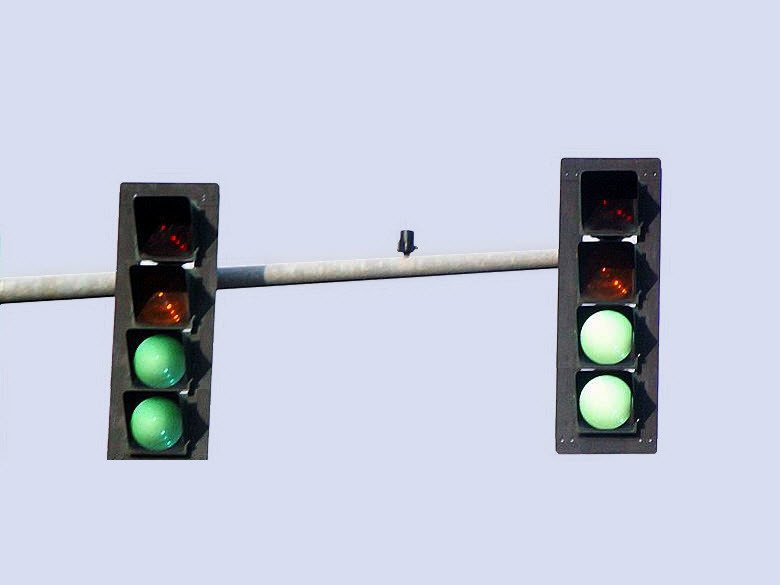
Red means stop. Green means go. White means… What?
At a traffic light, red means stop, and green means go. But transportation engineers at North Carolina State University are now proposing a “white light,” which would enable autonomous vehicles to help control traffic flow – and let human drivers know what’s going on. In computational simulations, the new approach significantly improves travel time through intersections and reduces fuel consumption.
Ali Hajbabaie, associate professor of civil, construction and environmental engineering at NC State, explained.
“This concept we’re proposing for traffic intersections, which we call a ‘white phase,’ taps into the computing power of autonomous vehicles (AVs) themselves. The white phase concept also incorporates a new traffic signal, so that human drivers know what they are supposed to do. Red lights will still mean stop. Green lights will still mean go. And white lights will tell human drivers to simply follow the car in front of them.”
The white phase AV signal
The white phase concept rests on the fact that AVS can communicate wirelessly with both each other and the computer controlling the traffic signal. When enough AVs are approaching the intersection, this will activate the white light. The white light is a signal that AVs are coordinating their movement to facilitate traffic through the intersection more efficiently. Any non-automated vehicles – those being driven by a person – would be required to follow the vehicle in front of them: if the car in front of them stops, they stop; if the vehicle in front of them goes through the intersection, they go through the intersection.
When too many vehicles approaching the intersection are controlled by drivers rather than AVs, the traffic light would revert to the conventional green-yellow-red signal pattern.
“Granting some of the traffic flow control to the AVs is a relatively new idea, called the mobile control paradigm. It can be used to coordinate traffic in any scenario involving AVs. But we think it is important to incorporate the white light concept at intersections because it tells human drivers what’s going on, so that they know what they are supposed to do as they approach the intersection. And, just to be clear, the color of the ‘white light’ doesn’t matter. What’s important is that there be a signal that is clearly identifiable by drivers.”
The researchers first introduced a “white phase” traffic intersection concept in 2020. However, that initial concept relied on a centralized computing approach, with the computer controlling the traffic light responsible for receiving input from all approaching AVs, making the necessary calculations, and then telling the AVs how they should proceed through the intersection.
“We’ve improved on that concept, and this paper outlines a white phase concept that relies on distributed computing – effectively using the computing resources of all the AVs to dictate traffic flow. This is both more efficient, and less likely to fall prey to communication failures. For example, if there’s an interruption or time lag in communication with the traffic light, the distributed computing approach would still be able to handle traffic flow smoothly.”
Testing the white phase traffic light concept
To test the performance of the distributed computing white phase concept, the researchers used microscopic traffic simulators. These simulators are complex computational models designed to replicate real-world traffic down to the behavior of individual vehicles. Using these simulators, the researchers were able to compare traffic behavior at intersections with and without the white phase and how the number of AVs involved influences that behavior.
“The simulations tell us several things. First, AVs improve traffic flow, regardless of the presence of the white phase. Second, if there are AVs present, the white phase further improves traffic flow. This also reduces fuel consumption, because there is less stop-and-go traffic. Third, the higher the percentage of traffic at a white phase intersection that is made up of AVs, the faster the traffic moves through the intersection and the better the fuel consumption numbers.”
When only 10-30% of the traffic at a white phase intersection was made up of AVs, the simulations found relatively small improvements in traffic flow. But as the percentage of AVs at white phase intersections increased, so did the benefits.
“That said, even if only 10% of the vehicles at a white phase intersection are autonomous, you still see fewer delays. For example, when 10% of vehicles are autonomous, you see delays reduced by 3%. When 30% of vehicles are autonomous, delays are reduced by 10.7%.”
White phase traffic signals not quite ready for primetime
The researchers acknowledge that AVs are not ready to adopt the new distributed computing approach tomorrow, nor are governments going to install brand new traffic lights at every intersection in the immediate future.
“However, there are various elements of the white phase concept that could be adopted with only minor modifications to both intersections and existing AVs. We also think there are opportunities to test drive this approach at specific locations. For example, ports see high volumes of commercial vehicle traffic, for which traffic flow is particularly important. Commercial vehicles seem to have higher rates of autonomous vehicle adoption, so there could be an opportunity to implement a pilot project in that setting that could benefit port traffic and commercial transportation.”
Image Credits
In-Article Image Credits
Four light traffic signal via Wikimedia Common with usage type - Creative Commons License. Used with modifications.Featured Image Credit
Four light traffic signal via Wikimedia Common with usage type - Creative Commons License. Used with modifications.








